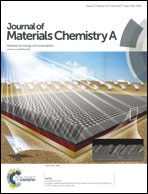Nanoflower-like weak crystallization manganese oxide for efficient removal of low-concentration NO at room temperature†
Abstract
The efficient removal of low-concentration nitric oxide at room temperature from a semi-closed space is becoming a crucial but challenging issue in the context of increasingly serious air pollution. A novel nanoflower-like weak crystallization manganese oxide (WMO) has been synthesized via a facile and scalable strategy for low-concentration nitric oxide oxidation at room temperature. The prepared WMO shows the nanoflower-like morphology with abundant water molecules and Mn vacancies inside. Such WMO could easily adsorb NO and quickly convert it into NO2via catalytic oxidization. Herein, the weak crystallization structure and the presence of Mn vacancies are identified to be mainly responsible for the adsorption and catalytic oxidation of NO. More importantly, it shows much longer lifetime in a moist stream of simulated feed gas than that under dry conditions, which can be attributed to the relative stability of the catalyst with hydrated surfaces. Comparative DFT-calculations are performed to reveal the catalytic effect of Mn-vacancies and hydrated surfaces in reducing the reaction barriers of rate-determining steps.


 Please wait while we load your content...
Please wait while we load your content...